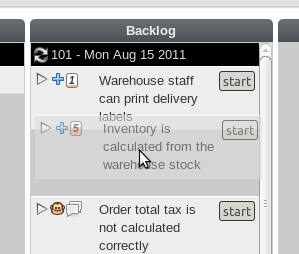Fulcrum

Fulcrum is an agile project management tool. It provides a real time overview of your project plan (product backlog), instantly adjusting the project plan based upon your team’s prior performance.
Fulcrum aims to create an experience as instantaneous and interactive as the traditional tool for agile project management, the whiteboard.
Story based task management
 In Fulcrum, tasks are broken up into ‘stories’. The aim is to describe the required behaviour of the system in a way that your product owner will understand. They typically describe a single interaction a user may have with the system. An example story might be ‘a user can add a product to their cart’ or ‘a user is notified when another user comments on one of their topics’.
In Fulcrum, tasks are broken up into ‘stories’. The aim is to describe the required behaviour of the system in a way that your product owner will understand. They typically describe a single interaction a user may have with the system. An example story might be ‘a user can add a product to their cart’ or ‘a user is notified when another user comments on one of their topics’.
Instead of estimating the time required to complete a story, each feature is given a relative difficulty score, given in ‘story points’. It’s up to the team to decide what each of these points represents, the most important consideration is to ensure the relative difficulty of each story. This is important for the calculation of velocity, discussed below.
Velocity and iterations
 Completed work is ‘time boxed’ into fixed length periods, called iterations. Each iteration is 1 week long by default, but can be modified.
Completed work is ‘time boxed’ into fixed length periods, called iterations. Each iteration is 1 week long by default, but can be modified.
Velocity is the measure of your team’s speed of progress. It’s calculated from the average completed story points from the most recently completed iterations.
The project’s velocity is used to automatically project forward progress for the upcoming iterations. This provides immediate visibility of when any feature is likely to be delivered to a surprisingly accurate level from very early on in the project’s lifetime.
Prioritisation

Fulcrum makes it easy, and even encourages, re-prioritisation of stories. Tasks are simply placed in the order of priority decided by the product owner, and the development team tackle them in this order.
Because the product owner can see the projected time line of the project at all times, they can change feature priority based on this knowledge. For example, it may be required to move a feature forward in the backlog to meet a deadline.
Any changes made to stories are propagated across all active users of a project in real time, so you can organise planning sessions with remote stakeholders and be sure that everyone is on the same page.
Story types
Stories are split into four types:
 Features are stories which bring business value to the project. They are the bread and butter of the product backlog. Features must be accepted by the product owner before they are considered done and contribute to the project velocity.
Features are stories which bring business value to the project. They are the bread and butter of the product backlog. Features must be accepted by the product owner before they are considered done and contribute to the project velocity.
 Bugs are pieces of functionality that are not working as intended. Because fixing a bug doesn’t carry any business value, bugs cannot be allocated points. They are an overhead of development, and don’t contribute to the project velocity.
Bugs are pieces of functionality that are not working as intended. Because fixing a bug doesn’t carry any business value, bugs cannot be allocated points. They are an overhead of development, and don’t contribute to the project velocity.
 Chores are technical tasks associated with the project, for example security upgrades, deployment set-ups etc. Like bugs, they don’t carry any business value for the project, and so cannot be allocated points. Unlike bugs they don’t need to be accepted by the product owner.
Chores are technical tasks associated with the project, for example security upgrades, deployment set-ups etc. Like bugs, they don’t carry any business value for the project, and so cannot be allocated points. Unlike bugs they don’t need to be accepted by the product owner.
 Releases represent key points in the project development. They can have an optional deadline date attached to them, and if they do Fulcrum will show whether the deadline is likely to be met or not.
Releases represent key points in the project development. They can have an optional deadline date attached to them, and if they do Fulcrum will show whether the deadline is likely to be met or not.
Find out more
Fulcrum is currently still in the development stage, and is currently best suited to battle-hardened Rails / Javascript developers. At present, the best way to try it out is to download it and give it a spin